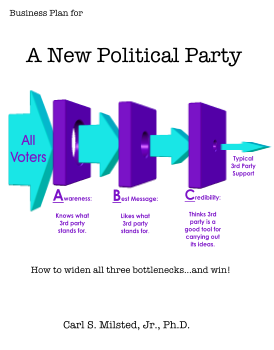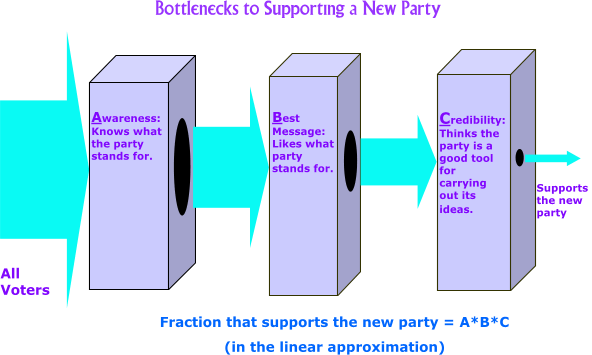Bottlenecks to Membership
There are at least three semi-independent factors that lead a voter to becoming a member/supporter of a new political party.
�
They are:
-
Awareness. Is the voter aware of the party and what its message is?
-
Best Message: Does the voter consider the new party’s message to be better than that of the other parties?
-
Credibility: Can the party carry out its message? Can it actually win elections? (This includes the lesser of two evils dilemma.)
For a voter to identify with a new political party, the party must meet all three criteria. Failure at any one of these three bottlenecks means failure to recruit the voter.
Because this is an “AND” relationship, we can express the fraction of voters that support the new party as the product of three fractions. Suppose that we get the message out to 25% of the voters, 25% of the voters like the message and 25% of the voters are unconcerned with the lesser of two evils dilemma, or are otherwise convinced that the party is credible. We end up with a support base of:
.25*.25*.25 = .015625, or about 1.6% of the voters
Wow! You think you are ¼ done and you only get 1.6% of the vote! This looks rather grim, but it matches many of the results seen in the field.
Fortunately, it is quite straightforward to do better with a similar amount of effort. I assumed that the three factors are completely uncorrelated in order to justify multiplying the three factors together. In reality, there are correlations. If you target your advertising to those who likely agree with your message then factors A and B become correlated. If you do a media blitz in a district where your candidate is in a two-way race, or your candidate is outspending at least one of the major party candidates, then you get a correlation between A and C. If such a race is in a district that leans in your direction ideologically, then you get correlation between all three factors.
Suppose we have a district where half the voters prefer your message, and you are in a two way race. Outreach to ¼ of these voters yields something like:
.25 * .5 * .8 = 0.1, or about 10% of the vote
By choosing our battles, we do over six times better! Actually, I am a bit pessimistic in choice of numbers above. In a two-way race you just have to be preferred over one of the major parties, so doing better than .5 is possible (if you aren’t overly radical). The credibility factor is hard to judge. There is no lesser of two evils dilemma, but if you are new, you still have some questions about your credibility. Some people will simply push the straight ticket lever. On the other hand, you get a nice chunk of protest votes.
Oh, I neglected to mention that this formula shows the earned votes. You need to tack on the protest vote as an addend. In a three-way race, about 3% or so tends to go to non-major party candidates simply as protest votes. You can get these votes even if no one knows who you are. (Amount depends of level of race. It goes down for high level races like president.) You just need to be on the ballot. Sean Haugh, former executive director of LPNC, has told me that active LP campaigns often get fewer votes than paper campaigns because they lose some of the protest votes when some of the potential protest voters dislike the message. It takes an extra effort for the earned votes to outweigh the loss of protest voters.
Between correlations and unearned votes, it is safe to say that current third parties are doing less well than factors of ¼ for at least one of the bottlenecks. I would venture to state that fewer than 1 percent of the voting public would prefer the pre-2006 Libertarian Platform to what the Democrats and Republicans offered (Bottleneck B). That the LP has done better in many races stems from the fact that many voters did not know what was in the platform and/or they voted on the individual LP candidates who ran on considerably less radical positions. One weapon used by major-party candidates when Libertarians threatened to win or play the spoiler was to widen the first bottleneck by publicizing select portions of the LP platform.
Previous
| 1
| 2 | 3
| 4
| 5
| 6
| 7
| 8
| 9
| 10
| Next
Copyright 2007, Carl S. Milsted, Jr. All rights reserved.
|







